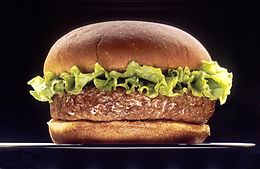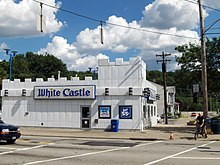hamburger
A hamburger ( burger for short ) is a sandwich that is widespread worldwide and consists of a special roll , the bun , which is topped with various toppings, but mainly a grilled slice of minced beef (the patty , a kind of minced steak ). It is often used as a hot quick meal or ready-made meal as a standard item in many fast food chains , but is increasingly finding its way into classic and even upscale gastronomy .
etymology
The exact origin of the word "Hamburger" is not known. What is certain is that the first syllable "ham" anything (with the English-language "Ham" German background ham has) to do. Rather, it was derived from the acronym for fried minced meat ( English hamburger steak ), which Hamburg immigrants introduced in the 19th century. This was also confirmed by an American dictionary of etymology.
There are competing theories about the origin of the hamburger:
- Several hypotheses assume that the name can actually be traced back to the German city of Hamburg . There is the traditional round piece warm snack in Hamburg . This consists of a wheat roll ("round piece") with a slice of roast in it and gravy that is poured over it. Another variant of this “Hamburger piece” consists of a wheat roll with a minced meatball made from beef steak and egg yolk. This recipe, so the hypothesis, came to the USA with German immigrants . In addition, meatballs with bread rolls were a popular dish on the emigrant ships that often left Hamburg. At the 1904 World Exhibition in St. Louis , such minced meat rolls - yet without the "he" ending - were verifiably sold as "Hamburg".
- In an American cookbook from 1842, the term hamburger steak appears for a steak made from ground beef ( American English ground beef , British English minced meat ). The minced steak was also called "Hamburger Style Steak", named after the northern German city.
- Another theory, however, says that the name originated in 1885 at a fair in Erie County near the American city of Hamburg near Buffalo in the US state of New York . There the Menches Brothers had a snack stand where they experimented with beef as a substitute because of a shortage of roast pork ( English Hot Pork ). They named their creation Hamburger, according to the place of birth . This theory is officially propagated by the State of New York with the slogan New York's Gift to World Cuisine, The Hamburger , but it is widely questioned.
- Another theory says that in the first years of settlement in the USA (before cattle breeding was established) imported beef (mainly via the port of Hamburg , cooled with ice cream ) was a luxury good, the slang word Hamburg generally referred to beef of high quality; so this should be emphasized.
The English word “hamburger” can stand for the type of minced meat used (lean ground beef) as well as for the bare meat structure without rolls and other ingredients. If this meat was placed in bread or a roll, it was called a hamburger sandwich . In the middle of the 20th century, both terms were shortened to hamburgers or just burgers . In German, always the entire snack of meat with hamburger or burger and bun meant in the GDR - kitchen , the concept was Grilletta common.
history

The first “burger-like” dish comes from Chinese cuisine and is called Roujiamo (also Rougamo). It was invented in Shaanxi during the Qin Dynasty (around 2200 years ago) and is still a popular street food today .
The first hamburger was probably served in 1900 as a “steak sandwich” in the “Louis' Lunch” of the German immigrant Louis (Ludwig) Lassen in New Haven . It consisted of ground beef ( English ground beef ), the two slices of bread was covered. The takeaway is still in the center of New Haven at 261 Crown Street. There the hamburger is still served in its original way - with onions, tomatoes and cheese, but without mustard or ketchup . Louis Lassen allegedly served a guest in a hurry around 1900 with these ingredients, grilled minced meat, homemade from unsold steaks, between two slices of toast. The guest was delighted and, so the story goes, a new kind of American sandwich was born.
According to a resolution by the Wisconsin legislature, Charlie Negrin, who is said to have been known as Hamburger Charlie , is said to have sold hamburgers in Seymour, Wisconsin for the first time in 1885 . In contrast, the governor of Oklahoma decided in 1995 that Oscar Bilby had first sold hamburgers in Tulsa in 1891.
In 1925, when asked about the favorite food in New York restaurants, the hamburger came in 19th place.
The opening of the first McDonald’s restaurant on April 15, 1955 with the core business of cheeseburgers , French fries and milkshakes in Des Plaines is considered the commercial beginning of the fast food idea. Dick and Mack McDonald had eight multi-mixers for milkshakes made by Ray Kroc . Together with him, they founded a franchising company on March 2, 1955 , which already saw 18 newly founded restaurants in the first year. The idea for this fast food was based on the consideration that very few employees in the USA have a canteen and therefore have to have their lunch outside during the short lunch break .
In October 1944, Weltwoche wrote: "The omelette has become a 'Virginia Ham', if not a Hamburgher ( sic !)". The McDonald's Deutschland GmbH started in September 1971, on December 4th 1971 the first German branch opened in the Martin-Luther-Strasse in Munich in the district of Obergiesing , it is still in operation today. The first branch in the new federal states was opened on December 21, 1990 in Plauen , Saxony .
variants
There are hardly any limits to the variety of the burgers “prepared like a hamburger”. One of the most common variants is the cheeseburger , a hamburger with additional cheese. Burgers that are not topped with beef are, for example, chicken burgers, fish burgers (such as the so-called Bremer ), pulled pork or pulled beef burgers or vegetarian variants such as the veggie burger , which are usually topped with vegetable patties . Various Swiss retailers have also been offering insect burgers since August 2017 .
Food law in Germany
In Germany, the composition of the meat slice in a hamburger or beefburger is defined in the guiding principles for meat and meat products of the German Food Book. It must therefore exclusively of coarse entsehntem beef are produced and optionally salt and spices contain. No other ingredients are allowed. This regulation only applies to products that are offered under the name "Hamburger" or "Beefburger". Since December 1, 2014, the “cheeseburger” has also been regulated in the guiding principles under section 2.507.4. This is a hamburger with cheese or processed cheese on it. Unless otherwise stated, the meat component of a cheeseburger must now also consist of pure beef, possibly salted and seasoned, this is checked regularly and without notice.
See also
Web links
|
Further content in the sister projects of Wikipedia:
|
||
|
|
Commons | - multimedia content |
|
|
Wiktionary | - Dictionary entries |
|
|
Wikibooks | - Textbooks and non-fiction books |
- The history of the hamburger: An American invention
- Article by the arte magazine "Karambolage" on the subject
- Assumptions about the history of the hamburger , one day , January 6, 2008
- Check Out What McDonald's Does To Its Burgers Before They Appear In Ads. In: The Business Insider , June 20, 2012, photo series about the production of advertising photos for hamburgers and the comparison with real hamburgers ( McDonald’s and Burger King ).
Individual evidence
- ^ Friedrich Kluge: Etymological dictionary of the German language . 24th edition, Berlin 2002
- ↑ Christoph Gutknecht, puff cake! Lauter culinary word stories , 2002, p. 97 f.
- ^ Robert K. Barnhart, Dictionary of Etymology , 1995, p. 340
- ↑ State of New York, Department of Economic Development, Bureau of Media Services: New York Traveler , 1995–1996, p. 94
- ↑ The World's First Hamburger Comes From Where? April 8, 2015, accessed December 6, 2019 .
- ↑ Khushbu Shah: China Brazenly Claims it Invented the Hamburger. April 14, 2015, accessed December 7, 2019 .
- ↑ Tony Tan: What is rou jia mo? Retrieved December 7, 2019 .
- ↑ 肉夹馍 英译 Rougamo 泡 馍 标准 黄豆 粒 大小. Retrieved December 7, 2019 .
- ↑ Colin M. Caplan, Legendary Locals of New Haven , 2013, p. 108
- ^ History ( Memento of July 17, 2012 in the Internet Archive ), louislunch.com
- ↑ Louis' lunch. A Local Legacy , americaslibrary.gov
- ↑ Hans J. Kleinsteuber: Is the Hamburger a Hamburger? In: Hamburger Abendblatt from August 10, 2011.
- ↑ BEEF AND CABBAGE OUR FAVORITE DISH; Poll of New York Restaurants for 3 Weeks Gives Victory to Humble Fare. In: The New York Times . June 15, 1925, ISSN 0362-4331 ( nytimes.com [accessed March 24, 2020]).
- ^ Sara Gilbert, The Story of McDonald's , 2009, pp. 1 f.
- ^ Sara Gilbert, The Story of McDonald's , 2009, p. 4
- ↑ World Week of October 20, 1944, omelette
- ↑ Sales start of new foods: The insect burgers will hit the shelves next week . In: Neue Zürcher Zeitung . August 14, 2017, ISSN 0376-6829 ( nzz.ch [accessed September 8, 2017]).
- ↑ BMELV : German Food Book , Guidelines "Meat and Meat Products " (PDF; 294 kB), 2.507.2



